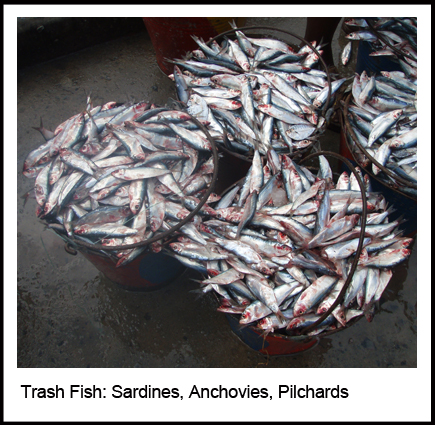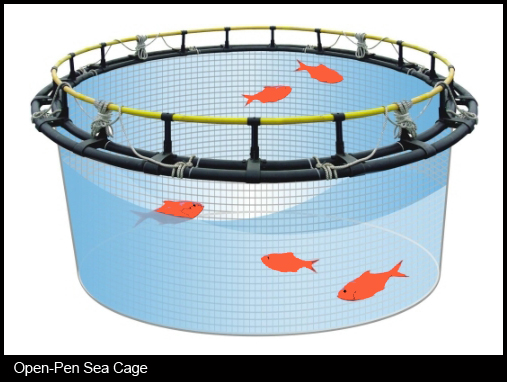Open-Pen Sea Cage Aquaculture has its advantages and drawbacks, like any method of aquaculture. We’ve outlined some of these in our Introduction to Sea Cage but now we’ll start to look in more detail at some of them.
The five “fundamental flaws” of sea cage aquaculture are; discharge of untreated wastes, mass escapes, diseases and parasites (which can spread to wild populations), the use of toxic chemicals and fish feed. The first four flaws have been addressed considerably in recent years as regulatory bodies have caught up with the swiftly expanding aquaculture industry. They can be mitigated by waste treatment, closed containment, improved environmental practices and correct farm positioning. They are also the focus of much of the environmental monitoring and regulation to which operations are subject.

Feed
One of the biggest issues with Open-Pen Sea Cage Aquaculture is the use of feed that contains fishmeal from wild sources. Pellets that are fed to farmed fish contain many land-based crops and alternative proteins, but as most of the species farmed are carnivorous or omnivorous they require at least some fishmeal to provide necessary amino acids. The fish most commonly ground into fishmeal are small, oily, schooling species such as anchovies, sardines and pilchards – sometimes known collectively as ‘Industrial Fish’. Roughly 20 million tons of these fish are caught for aquaculture each year. In Australia we catch more Sardine than other single species – but the majority of the catch is not suitable for human consumption. In South Australia 97% of the sardine catch goes to feed the Southern Bluefin Tuna ranched in Port Lincoln.
Conservation groups often mention the use of wild-caught feed as the fundamental reason for their ‘red-listing’ of Sea Cage Aquaculture species. Tooni Mahto, Marine Campaigner for the Australian Marine Conservation Society (AMCS) explains; “Aquaculture of finfish species like salmon is still heavily reliant on wild caught feed… meaning the environmental footprint of the aquaculture operation extends far beyond the physical boundaries of a pen.”
Tim Dempster is a senior lecturer in Marine Ecology at Melbourne University. He studies the ecological effects of fisheries and aquaculture, and has done a lot of work with salmon farms in particular. He points out to us that though 20 million tons of ‘trash fish’ are caught for aquaculture each year, these fish have remained “relatively stable in catch over the past several decades”. He also mentions that, somewhat surprisingly, “Aquaculture does not appear to have driven an increase in the catch of these species”. This is because before aquaculture these species were still caught in great numbers – to be fed to chickens and pigs. And now? “As Salmon and other fish are efficient converters of protein because they are cold-blooded animals, this wild fish protein source is now used far more efficiently..”
Feed – Efficiency is Key
Efficiency of feed is key to farming fish. Feed is one of the biggest costs for a farm, so it is not in their interest to waste it. Steven Gill is Manager of Post Harvest Development at Marine Produce Australia, producers of ‘Cone Bay Barramundi’. He points out that “Feed manufacturers in Australia put a great deal of R&D into replacing fishmeal with other protein and oil sources and the reliance on fishmeal is reducing all the time”. The reasons for this? “One, it is really expensive and two, supply is limited and becoming more so”.
 Efficiency is usually discussed using a Feed Conversion Ratio (FCR). This is a measure of how much feed is used to grow each kg of farmed fish. For example, the ratio cited by AMCS for farmed salmon is 3:1. This means that for every kg of farmed Atlantic Salmon produced, 3kg of feed is needed. These feeds are formulated to have optimum protein, carbohydrate, lipid, fat and water stability levels that will maximise the production of healthy, fast growing fish. As such, these feeds are manufactured from a range of ingredients, which include wild caught fishmeal and fish oil. A common mistake in interpreting FCRs is assuming that every gram of feed used is wild-caught fishmeal or fish oil, which of course it is not. Steven Gill points out “My understanding is that the feed we use on our farm has less than 5% fishmeal”. Cone Bay Barramundi’s achievements in feed efficiency are one of the reasons it was recently identified by the ACF as a sustainable seafood producer.
Efficiency is usually discussed using a Feed Conversion Ratio (FCR). This is a measure of how much feed is used to grow each kg of farmed fish. For example, the ratio cited by AMCS for farmed salmon is 3:1. This means that for every kg of farmed Atlantic Salmon produced, 3kg of feed is needed. These feeds are formulated to have optimum protein, carbohydrate, lipid, fat and water stability levels that will maximise the production of healthy, fast growing fish. As such, these feeds are manufactured from a range of ingredients, which include wild caught fishmeal and fish oil. A common mistake in interpreting FCRs is assuming that every gram of feed used is wild-caught fishmeal or fish oil, which of course it is not. Steven Gill points out “My understanding is that the feed we use on our farm has less than 5% fishmeal”. Cone Bay Barramundi’s achievements in feed efficiency are one of the reasons it was recently identified by the ACF as a sustainable seafood producer.
Of industry developments, Tooni Mahto states that; “Whilst we (the AMCS) are aware of advances in the aquaculture industry to improve FCRs and environmental performance, overall, significant improvements are still required for an ecologically sustainable approach to be achieved in open-pen sea cage aquaculture of finfish.”
Of course, feed ratios differ massively between operators and species. Feed manufacturers in Asia are likely to have a greater percentage of wild-caught fishmeal in their feed, and some operators here may import feed from these manufacturers. Of the species farmed in Australia, Southern Bluefin Tuna has the worst feed conversion ratio, around 10-12kgs for every kg of Tuna grown. Improvements in salmon culture, meanwhile, have achieved feed conversion ratios of less then 2kg.
Alternative Protein Sources?
The AMCS points out, quite rightly, that “Fin fish aquaculture in particular must continue to reduce reliance on fish protein, increase use of ‘off-cuts’ from sustainable wild fisheries and move towards farming of fish that require low levels of or no animal protein to grow”. This has been recognised by the industry, which wants to ensure a viable future. Linda Sams, Chief Sustainability Officer at Tassal (Australia’s biggest salmon producer) tells us that “Tassal is actively participating in research on new feeds to ease pressure on fish and fish oil based feeds”.
Alternative protein sources such as plant-based proteins and vegetable oils are currently the focus of much industry research. The use of these to replace some or all of the fishmeal-based proteins in feed for farmed fish will reduce costs and alleviate pressure on wild-caught fish stocks. However, it will bring new issues to the forefront of the feed debate, such as increased land-use for crops, decreases in omega-3 content in fillets and possible use of genetically modified crops/feeds.
One of the problems with plant-based proteins is that only wild-caught proteins contain the long-chain omega-3 fatty acids that also provide health benefits to humans. These are produced by marine algaes and move up the food chain, culminating in higher concentrations. John Ford is a marine scientist at Melbourne University. He clearly states the dilemma: “We can only seriously expand this type of aquaculture if we increase efficiency of feeding. Alternatively we can feed fish non-fish based protein, however this does not result in the high omega 3 levels expected by consumers. A conundrum.”
Other Issues
The other major issues associated with Sea Cage Aquaculture have varying degrees of relevance and impact in the Australia scenario. Two of the biggest issues in the Northern Hemisphere industry are the spread of disease and parasites (such as sea lice) to wild populations and the risks of farm escapees interbreeding or competing with wild populations, which leads to species declines. Tim Dempster, with extensive knowledge of Salmon farming operations worldwide, explains that “As wild salmon populations do not exist in Australia, neither of these impacts are of concern in the Australian context.” Escaped Atlantic Salmon are not thought to be able to survive or form breeding populations in Australian waters. Which is not say we are home free, as sea-cage operations have many other environmental impacts, such as nutrient release, antibiotic use and chemical use.
 John Ford tells us that “Wastewater is an issue on some farms but not others, depending on location, but in general it is not as bad as many perceive. Fortunately, sea cage aquaculture has come a very long way from 20 or 30 years ago, when waste water was a big problem due to inappropriate positioning of farms and poor control of feed and feeding practices. A sea cage aquaculture system in a high flow environment represents a significantly lesser impact than a pond aquaculture system disposing of waste into a sheltered bay”. Healthy Oceans Campaigner Chris Smyth from the Australian Conservation Foundation (ACF) adds that “Each operation should be assessed separately in terms of ecological sustainability. In general, such operations should not be located in areas of high conservation value, in shallow water or areas of low currents (strong currents aid the dispersal of nutrients) … generally speaking, the further offshore sea cages are the lower the impact.”
John Ford tells us that “Wastewater is an issue on some farms but not others, depending on location, but in general it is not as bad as many perceive. Fortunately, sea cage aquaculture has come a very long way from 20 or 30 years ago, when waste water was a big problem due to inappropriate positioning of farms and poor control of feed and feeding practices. A sea cage aquaculture system in a high flow environment represents a significantly lesser impact than a pond aquaculture system disposing of waste into a sheltered bay”. Healthy Oceans Campaigner Chris Smyth from the Australian Conservation Foundation (ACF) adds that “Each operation should be assessed separately in terms of ecological sustainability. In general, such operations should not be located in areas of high conservation value, in shallow water or areas of low currents (strong currents aid the dispersal of nutrients) … generally speaking, the further offshore sea cages are the lower the impact.”
The Southern Bluefin Tuna aquaculture industry in Australia is “the most exposed to environmental uncertainty and sustainability concerns” according to lecturer Tim Dempster. This is due to its reliance on wild Tuna stocks for fattening, which are fished from a population recently listed as “Critically Endangered” by the International Union for Conservation of Nature (IUCN) and considered to be at only 5% of their pre-fishing biomass. As mentioned previously, Tuna aquaculture also has the worst FCR’s of any fin fish farmed in Australia, a high reliance on wild-caught feed and a greater waste output than other aquacultured species.
What can consumers do? Attempt to identify species that are inherently more sustainable or producers who are taking steps to ensure their fish is produced as sustainably as possible. Choose species that are, if not herbivorous, at least less reliant on wild-caught feed in their diets and more efficient at converting their feed into edible meat. Choose to know your producer and their environmental record and goals. As Tooni Mahto tells us “There are individual producers who are working towards more sustainable practices and should be considered market leaders.” These producers should be supported so that their competition and the market as a whole realise the competitive advantage and marketing opportunities that will arise from sustainable practices.

1 Comment